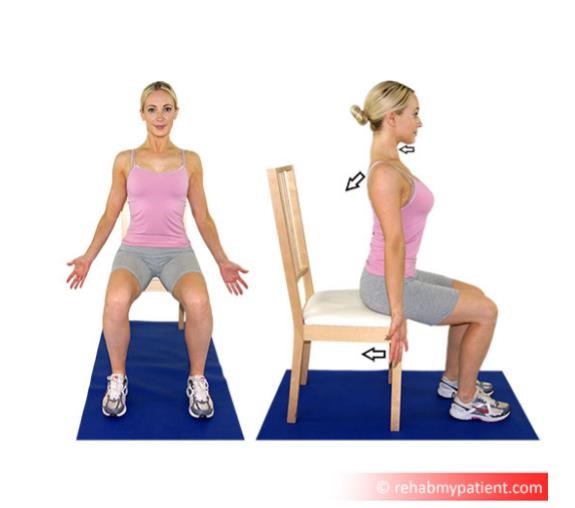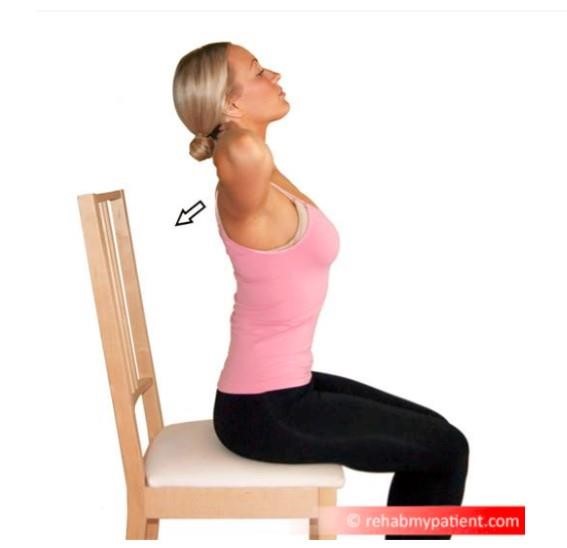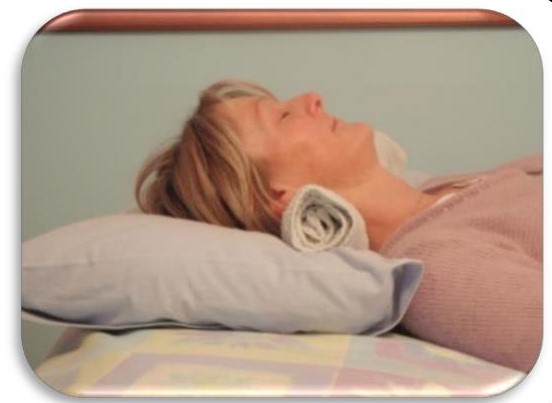Neck Pain Information for
Patients and Carers
- Neck pain is very common in all ages. Two out of three people will have neck pain at some point in their lives.
- In most cases, it is not due to a serious disease or neck problem and often the exact reason for neck pain can be unclear.
- Neck pain can be associated with other symptoms like stiffness, headaches, light-headedness, clicking or grating noises, pain down the arm or shoulder blade, or tingling down the arm. These symptoms as well are often not due to a serious disease or injury.
- Most cases of neck pain get better on their own within a few weeks. It can take 2 weeks for pain to ease and 6-8 weeks for pain to reduce significantly.
Why does my neck hurt?
- Physical effort: that exceeds your capacity. All joints and soft tissues in the body have a certain capacity for activity that they can tolerate. This can depend on how much activity you normally do. If you do an activity that takes you over this level or a repetitive activity that exceeds this capacity, you can present with a painful reaction. For example, if you are painting the ceiling for long hours or sitting at your desk for prolonged time without movement.
- Trauma: Such as falls, sports injuries and car accidents can expose your body to a rapid change in movement and/or blunt impact. This force can cause injury to the body’s tissues and lead to swelling and inflammation.
- Inactivity and sustained positions: Remember, keeping active is important!
Non-physical factors can also influence your pain such as:
- Emotional stresses: For example anxiety and depression, family or occupational issues can lower your pain tolerance, resulting in you experiencing more pain.
- Lifestyle factors: Such as disturbed sleep, poor diet, lack of exercise/activity and smoking can also contribute to back pain.
With simple advice provided within this booklet, your neck pain should settle within 6- 8 weeks. It is important that you maintain active and continue as normal. However, if your neck pain is persistent and severe then you should seek medical advice for the appropriate treatment.
Should I be resting or moving?
Neck pain can be very uncomfortable or unpleasant. However it is not dangerous.
There is no need to rest your neck. In fact, trying to maintain activity as tolerated can actually be good for recovery.
For the first few days:
- Take painkillers for pain relief: Painkillers can keep you moving. However, it is important to discuss with your GP especially if you’re taking other medication
- Try to stay active: Even if it means changing the way you do your normal activities.
- Applying heat or ice packs to the back of your neck can offer some relief. Wrap the heat or ice pack in a towel to avoid burns or scalds to your skin and leave for 10 minutes at a time.
- Arrange your pillows in bed to ensure good support to your neck.
After the first few days:
- Try to move your neck more. Resume your activities as normally as possible and stay or return to work as this is better for your recovery.
- Modify aggravating activities until you have less discomfort and better movement.
- Do gentle exercises to help your neck and relieve pain. (See below for more guidance)
Activity Diary and Modifications:
It can be useful to take note to try and identify which activities aggravate or flare up your neck pain. Below are some common neck aggravators and some possible modifications to relieve discomfort.
|
Aggravating Activity
|
Modification
|
|
Sustained or repetitive looking up Or poking the chin forward. (e.g. standing on a stool or step ladder, trying to look closely at the computer screen, exercising while leading with the chin)
|
Take periodic breaks from activity and/or change your position every 20-30 minutes.
|
|
Sustained or repetitive looking down (e.g. reading a book, looking at phone)
|
Take periodic breaks from activity and/or change your position every 20-30 minutes.
|
|
Increased stress and tension
|
Regular relaxation breaks throughout the day, yoga and walking.
Rest your arms on a high counter or table, or on two cushions over your knees.
|
|
Reaching, lifting and other arm movements
|
Move closer to the object you are trying to reach, use both arms to distribute the weight of the object or use the other arm until your pain improves.
|
|
Sleeping
|
Arrange the pillows to have enough support for the neck and be at neutral height (not too thick or too thin)
|
Should I use Ice or heat pack?
Most people find relief using a warm scarf or a heat pack on their neck to relieve tension and pain after the first few days of neck pain. However in the first few days, or if there is an irritated nerve sometimes ice packs can relieve symptoms too. Make sure that your pack is not too hot or too cold by wrapping it in a towel. Apply the packs for 10-15 minutes at a time and repeat three to four times a day allowing your skin to rest in between applications for at least 2 hours.
What about work?
It will help speed up your recovery if you stay or return to work as early as possible. Do not worry if you are still experiencing neck pain as you may only be required to do light duties at first.
Trying to maintain normal activity and regular movement while applying the necessary modifications to make tasks more manageable can be very important for recovery. Speak to your manager about any concerns you might have.
Do I need tests?
Usually not. Your doctor will be able to make a diagnosis of neck pain from your description of the pain and through their examination. Therefore, in most cases, tests are not needed. In fact, some research has shown that tests can actually do more harm than good when diagnosing neck pain.
For example, the technical words used to report x-rays can sound alarming when in fact they are just showing normal changes that are not related to the cause of pain. This can be harmful as it can cause unnecessary fear and worries about movement and activity when it is actually safe and also necessary to keep moving for recovery.
However, your doctor might suggest X-rays or other tests if they are uncertain about the diagnosis or if they want to exclude certain problems.
What are the aims of Physiotherapy in neck pain?
The aim of physiotherapy is to increase movement in your joints, improve your muscle strength and try and relieve pain, discomfort and other symptoms like headaches, light-headedness or tingling.
What can I do to help myself?
The majority of neck problems can be improved and/or managed by maintaining a level of activity and using self-management techniques.
Exercises:
Regular exercise is very important for neck pain, as it keeps the joints and soft tissues conditioned and healthy. It is important to carry out any exercises regularly.
Alter the frequency or intensity if the pain seems worse at first with exercise. The body will adapt to them, and you will be able to build from there. General cardiovascular exercise, like walking, is also very important.
The following are some gentle neck exercises that can be helpful:
Photographs from ©Rehabmypatient.com
Posture
There is no good or bad posture, just what is comfortable for you at the time. If you spend long periods of time in prolonged positions, like in sitting (e.g.at a desk), lying down for a period (e.g. in a bath) or with activities involving working with your arms up high or looking up for long periods (e.g. plastering), you are better moving your neck and altering your posture or activity at regular intervals with regular rest breaks.
The following are two positions that can help you get out of prolonged posture:
Photographs from ©Rehabmypatient.com
Lying
If you wake up in the morning with increased pain and stiffness in your neck, you may need to correct the position in which you sleep. A pillow should support your head and neck by filling in the natural hollow of the neck between your head and shoulders. Ideally only use one pillow. If you remain in discomfort, you may benefit from a supportive roll placed inside the pillow case to support the hollow of your neck for example a rolled towel. This should go on the underside of the pillow at the bottom edge.
What other factors can contribute to my pain?
Most cases of neck pain get better on their own within a few weeks. It can take 2 weeks for pain to ease and 6-8 weeks for pain to reduce significantly. However this varies from person to person and sometimes neck pain can persist beyond that time due to a number of factors.
Persistent pain does not mean ongoing damage, even though it might feel like it. Previously this was thought to be due to not healing fully after an injury however now for most people we know this is very unlikely. Instead, persistent pain has less to do with injury and more to do with how pain is processed by our brains.
It’s like the volume knob on our pain system has been left turned up like a radio stuck on ‘loud’, in this case we say that the neck is ‘sensitized’. This volume can be turned down, or made less sensitive again. However it will require effort and time to achieve.
How do I know if I’m sensitized?
Getting disproportionate pain when doing simple activities that are not normally painful like sleeping, turning your head from one side to the other or reading or working on a computer for short amounts of time can be a sign of sensitization.
The Pain System can be sensitized due to the following reasons:
Psychological factors: research tells us that previous history of anxiety and depression are likely to make our pain system more sensitive. The same applies to those who suffered trauma either psychological or physical around the beginning of pain. Emotional stresses about family or work, fears around your condition or moving your neck can all contribute to the sensitivity of your pain system.
Sleep: research tells us that consistent poor sleep of less than 6 hours can cause more pain sensitivity. Even one poor night sleep can cause the next day to be more painful.
Lifestyle choices: research tells us that smoking, lack of adequate exercise (150 mins per week), and being overweight can cause an increase in pain sensitisation due to a potential reduction in the production of pain-relieving chemicals in the brain.
What can I do if these factors fit with me?
Firstly, knowing that these factors may be influencing the sensitivity of your pain can help justify what you are going through and reduce some of the fear associated with your condition. It is then important for you to try and address some of the factors you believe are related to your pain.
You may want to consider a healthier diet, find out ways to increase your exercise levels without increasing your pain and address factors related to stress and sleep health. See the advice in the following link - https://www.nhs.uk/live-well/.
If you are struggling to address these factors and you have other areas you need help with such as work-related issues then it is advisable to speak to your GP and gain a referral into a service that can help support you moving forward. The following services can help guide you:
- Physiotherapy service
- Pain Management Service
- Minds Matters Team.
What actions can I take to improve my health?
Evidence tells us that making healthy lifestyle choices can have a big impact on influencing problems with your muscles and bones and can play a major role in your overall health. Some of the most effective areas to address are below: (click on the links)
Maintaining a healthy weight - www.nhs.uk/live-well/healthy-weight/
Increasing levels of physical activity - http://www.nhs.uk/live-well/exercise/
Avoiding poor sleep patterns - www.nhs.uk/live-well/sleep-and-tiredness/how-to-get-to-sleep/
Reducing alcohol consumption - https://www.nhs.uk/live-well/alcohol-support/calculating-alcohol-units/
Stopping smoking - http://www.nhs.uk/live-well/quit-smoking/
Maintaining a healthy mind - http://www.nhs.uk/conditions/stress-anxiety-depression/
The good news is that you are able to influence lots of these by modifying your lifestyle. Therefore it is important that you consider addressing these areas alongside your current treatment.
You may wish to discuss any of these factors with your treating clinician who will be able to work with you and guide your long term management and support you to improve your wellbeing.
There will be information about the local services that exist within the waiting areas of the physiotherapy department and your treating clinician will be able to help signpost you to appropriate services.
The websites listed below give more information on local services available:
• Blackburn and Darwen - https://refreshbwd.com/
• East Lancashire - http://www.upandactive.co.uk/
• Public Health England https://www.gov.uk/government/organisations/public-health- england










